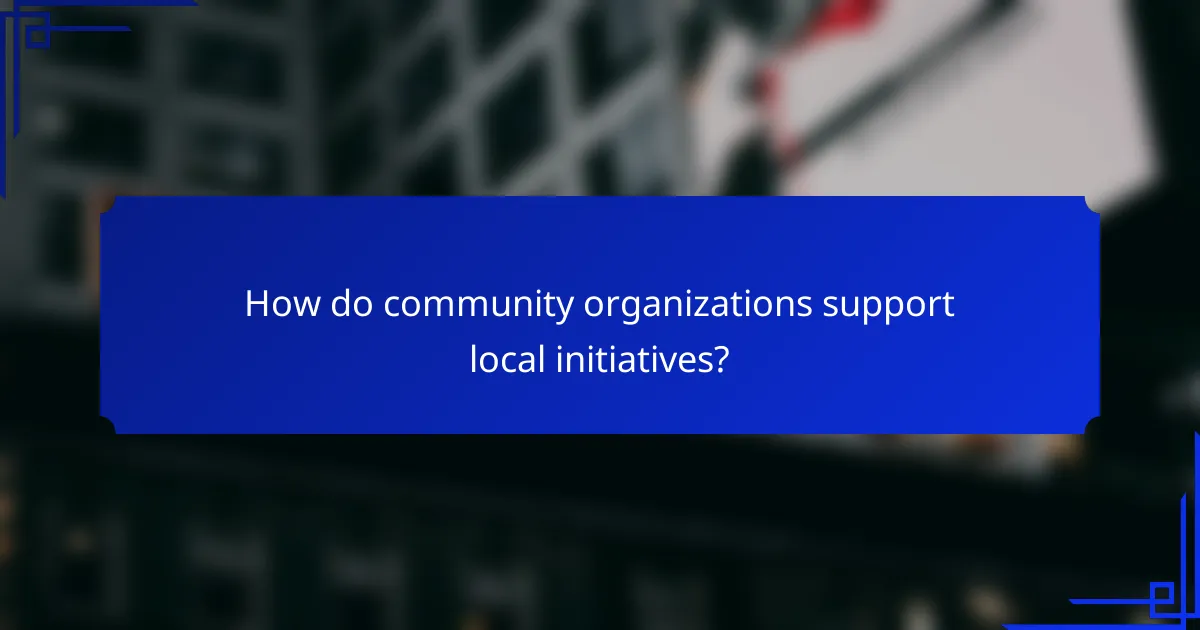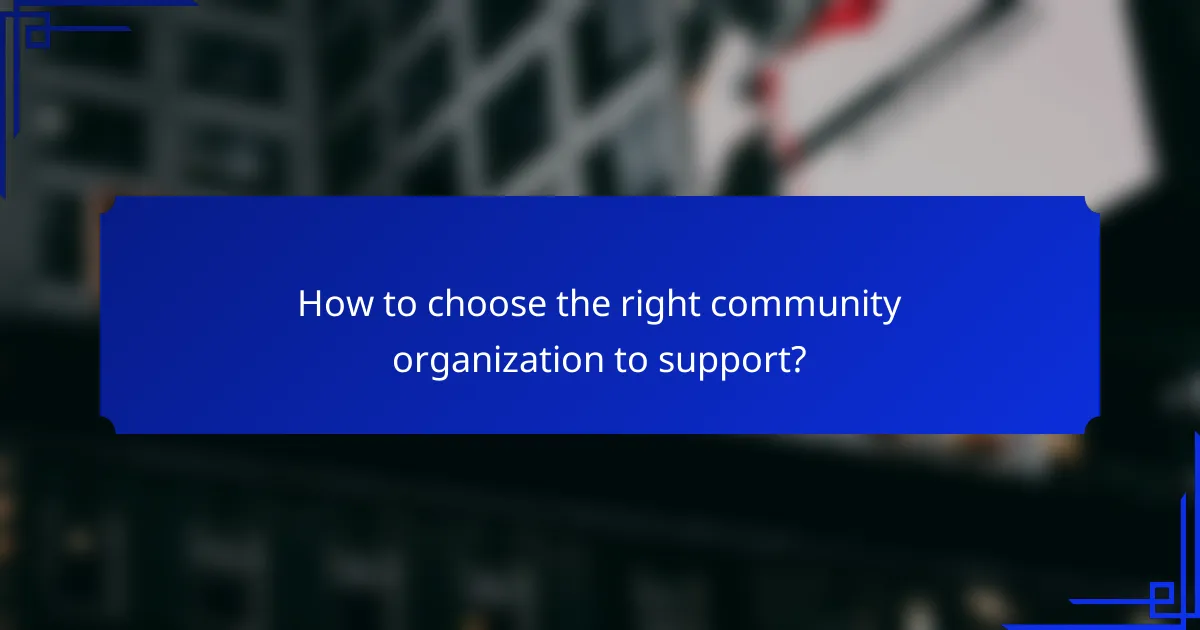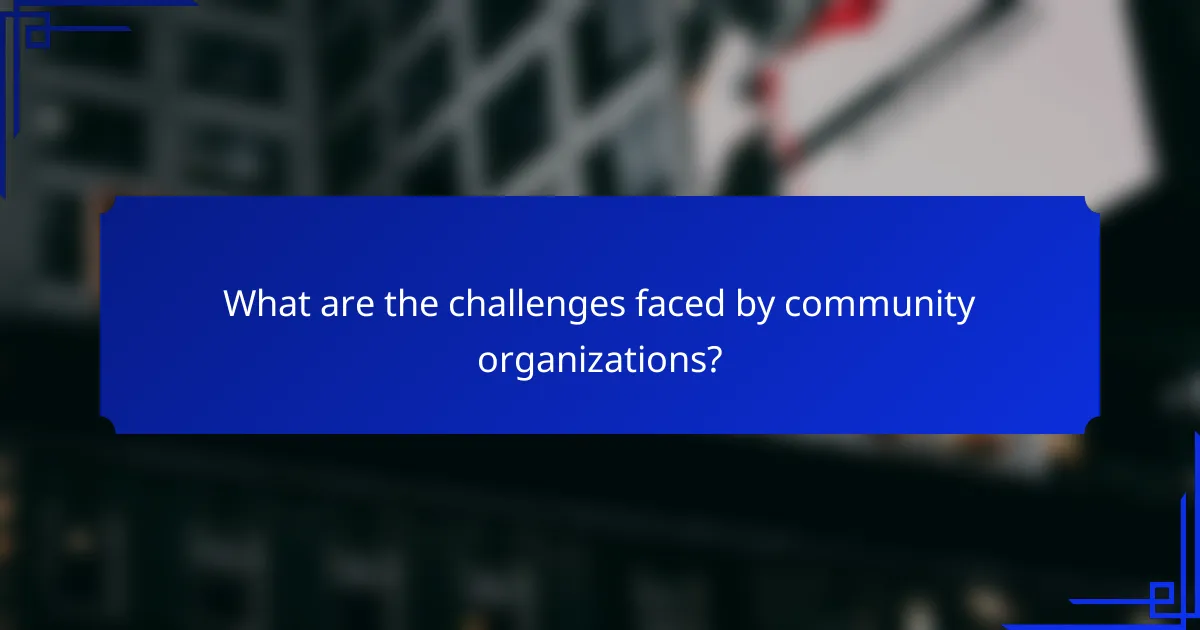Community organizations are essential in enhancing local initiatives by offering resources, funding, and volunteer support. They implement outreach programs that address critical needs such as health, education, and food security, fostering collaboration among residents to create a more resilient community.

How do community organizations support local initiatives?
Community organizations play a vital role in supporting local initiatives by providing resources, funding, and volunteer efforts. They foster collaboration among residents and stakeholders to address community needs effectively.
Funding and grants
Community organizations often secure funding through grants, donations, and local government support to finance initiatives. These funds can be used for various projects, including education, health, and infrastructure improvements. Organizations should research available grants and tailor their proposals to meet specific funding criteria.
For example, a local nonprofit might apply for a grant from a foundation focused on youth development, allowing them to launch after-school programs. Understanding the application process and deadlines is crucial for success.
Volunteer mobilization
Mobilizing volunteers is essential for community organizations to implement initiatives effectively. They recruit individuals who are passionate about local issues and provide them with training and support. This not only helps in executing projects but also fosters a sense of community involvement.
Organizations can use social media and local events to attract volunteers, ensuring they have a diverse group of participants. Clear communication about roles and expectations can enhance volunteer retention and satisfaction.
Resource sharing
Community organizations often engage in resource sharing to maximize impact. This includes sharing facilities, tools, and expertise among different groups. By pooling resources, organizations can reduce costs and increase efficiency.
For instance, two local nonprofits might share office space to cut down on rent while collaborating on joint initiatives. Establishing partnerships with other organizations can lead to innovative solutions and broader community reach.
Capacity building
Capacity building involves enhancing the skills and capabilities of community organizations to improve their effectiveness. This can include training staff, developing leadership skills, and improving organizational structures. Stronger organizations are better equipped to support local initiatives.
Workshops and mentorship programs can be beneficial in this regard. For example, a community organization might partner with a larger nonprofit to provide training sessions on grant writing and project management.
Community engagement
Engaging the community is crucial for the success of any local initiative. Community organizations facilitate dialogue and participation, ensuring that the voices of residents are heard. This engagement helps to identify priorities and fosters a sense of ownership among community members.
Methods for engagement can include town hall meetings, surveys, and focus groups. Organizations should strive to create inclusive environments where all community members feel welcome to contribute their ideas and feedback.

What outreach programs do community organizations offer?
Community organizations provide a variety of outreach programs designed to support local residents through essential services. These programs typically focus on health, education, environmental sustainability, and food security, addressing key needs within the community.
Health and wellness programs
Health and wellness programs aim to improve the physical and mental well-being of community members. These initiatives often include free health screenings, fitness classes, mental health workshops, and substance abuse counseling.
Many organizations partner with local health providers to offer services that may include vaccinations, nutritional counseling, and wellness fairs. Participants can benefit from expert advice and resources tailored to their specific health needs.
Education and tutoring services
Education and tutoring services focus on enhancing academic performance and lifelong learning opportunities. Community organizations often provide after-school programs, adult education classes, and one-on-one tutoring sessions for students of all ages.
These services may cover a range of subjects, from basic literacy to advanced mathematics and science. Engaging local volunteers or educators can help ensure that the tutoring is personalized and effective, catering to the unique learning styles of participants.
Environmental initiatives
Environmental initiatives aim to promote sustainability and conservation within the community. Programs may include community clean-up events, tree planting days, and educational workshops on recycling and waste reduction.
Organizations often collaborate with local governments and environmental groups to raise awareness about climate change and encourage eco-friendly practices. Participation in these initiatives can foster a sense of community pride and responsibility towards the environment.
Food distribution services
Food distribution services are crucial for addressing food insecurity in communities. Many organizations operate food pantries, meal programs, and community gardens to provide access to nutritious food for those in need.
These services often rely on donations from local businesses and volunteers to sustain operations. Community members can benefit from regular access to fresh produce and staple items, helping to alleviate hunger and improve overall health.

How to choose the right community organization to support?
Choosing the right community organization to support involves understanding their mission, evaluating their impact, and considering their local presence. This ensures your contributions align with your values and effectively benefit the community.
Assess mission alignment
Start by reviewing the organization’s mission statement to see if it resonates with your values and interests. Look for organizations that focus on causes you are passionate about, whether it’s education, health, environment, or social justice.
Consider how the organization articulates its goals and the specific communities it serves. A clear mission that aligns with your beliefs will enhance your engagement and satisfaction in supporting their work.
Evaluate impact metrics
Impact metrics provide insight into how effectively an organization uses its resources to achieve its goals. Look for data on their programs, such as the number of beneficiaries served or improvements in community conditions.
Many organizations publish annual reports or impact assessments that detail their achievements. Assess these documents to gauge their effectiveness and transparency. A good organization should be able to demonstrate tangible outcomes from their initiatives.
Consider local presence
Supporting an organization with a strong local presence can amplify your impact. Local organizations often have better insights into community needs and can mobilize resources more effectively.
Research their involvement in the community, such as partnerships with local businesses or participation in community events. A well-established local organization is likely to have a more profound understanding of the challenges faced by the community it serves.

What are the challenges faced by community organizations?
Community organizations encounter several challenges that can hinder their effectiveness and sustainability. Key issues include funding limitations, volunteer retention, and community engagement, all of which require strategic approaches to overcome.
Funding limitations
Funding limitations are a primary challenge for community organizations, often restricting their ability to implement programs and initiatives. Many organizations rely on grants, donations, and fundraising events, which can be unpredictable and insufficient to meet operational needs.
To navigate funding challenges, organizations should diversify their revenue streams. This can include applying for multiple grants, hosting regular fundraising events, and building partnerships with local businesses for sponsorships. Establishing a clear budget and financial plan can also help manage resources effectively.
Volunteer retention
Volunteer retention is crucial for community organizations, as a stable volunteer base ensures continuity and effectiveness in operations. High turnover can disrupt programs and lead to increased training costs for new volunteers.
To improve volunteer retention, organizations should focus on creating a positive and inclusive environment. Providing training, recognizing contributions, and offering opportunities for skill development can enhance volunteer satisfaction. Regular communication and feedback can also foster a sense of belonging and commitment among volunteers.
Community engagement
Community engagement is essential for the success of community organizations, as it helps build relationships and support for initiatives. However, engaging the community can be challenging, especially in diverse or underserved areas.
Effective strategies for enhancing community engagement include hosting events that cater to local interests, utilizing social media for outreach, and collaborating with other organizations. Listening to community feedback and adapting programs to meet their needs can also strengthen connections and encourage participation.
